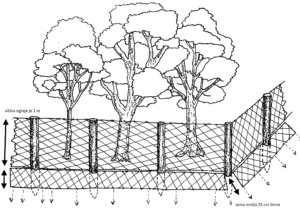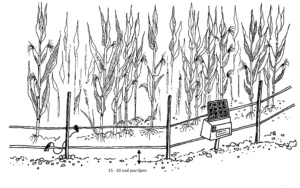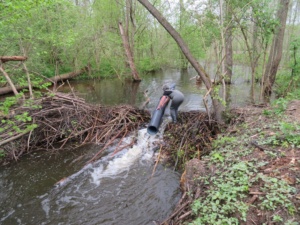TREE PROTECTION WITH A WIRE-MESH:
From late autumn to early spring, the beaver feeds on the bark of trees and shrubs. He mostly chooses trees up to 20 cm thick, but he can also tackle trees with a trunk diameter of more than 1 m. Beavers prefer softwood species (e. g. willows and poplars), but they also attack alder, ash, birch, oak and maple trees. They also like fruit trees. Wood is used as a construction material for beaver lodges (dens) and dams. Beavers most often feed very close to the watercourses (mostly they stay no more than 20 m away from water). If there is no woody vegetation near the water, they can also go further (up to 200 m) to get food.
There are several methods to protect trees from beavers. It is best to protect the trunk with a metal mesh (weldmesh); normally, it can be found in agricultural and gardening supply stores. Standard 2,5 x 5 cm (1 x 2 inch) weldmesh tree guards are good. In any case, the wire diameter should not exceed 5 cm. The wire-mesh must be as robust as possible (at least 2 mm thick), otherwise the beaver can remove it or bite through it.
The net must reach the ground and cover the roots as well. It should be installed in such a way that it does not hinder the growth of the tree. This is ensured by an appropriate distance of the net from the tree (at least 15 cm) or by installing springs that allow the net to expand as the tree grows.
The height of the net must be at least 1 m. When determining the height, we must also take into account possible snow cover or an increase in the water level. If the net does not stand by itself, it is also necessary to install one or more supports (e.g. wooden stakes that are driven into the ground and the net is attached to them).
A properly installed net provides 100% protection.
If we protect the entire orchard with a longer fence, it must be dug in to prevent the beaver from passing under the net (see the second picture). Another option for protecting the orchard is electric fencing. In this case, the lower electric wire should be placed 15 cm above the ground.
Note: Do not remove felled trees or those that have already been gnawed, otherwise the beaver will likely attack new ones!

TREE PROTECTION WITH AN ANTI-GAME PAINT:
Where meshing is not possible, the trunk, surface roots and lower branches can be protected with an anti-game paint.
The paint must be applied up to a height of 1-1.5 m, and in areas with a high snow cover, correspondingly higher. Painting is not suitable for trees smaller than 2 m (for them, meshing is a better option). Tree trunks that are narrower than 10 cm can be felled by beavers despite the paint. The condition of the paint must be checked periodically (e.g. every 5-10 years) and reapplied if necessary. The paint will wash off faster if the tree is more exposed (for example to floods).
One of the options for an anti-game paint is Wӧbra, which has proven effective against beavers; it can be bought from the German Flügel (https://www.fluegel-gmbh.de/). It does not damage the tree, nor does it change its appearance, as it becomes colorless soon after application.
We can also prepare the anti-game paint at home. We use oil- or latex-based exterior paint and fine sand with grains of 0.75 – 1 mm in size. Add 140-220 g of sand gradually (while mixing) to 1 liter of paint (different “recipes” can be found on internet). Use a color that is either transparent or similar to the color of the bark.
ELECTRIC FENCING:
A properly installed electric fence can effectively prevent beavers from feeding on arable crops. Wires must be installed low enough to ensure effectiveness even if a beaver wants to dig a hole under the wire. The bottom wire should therefore be placed 15 cm above the ground, and the next one 25 cm above the ground. The wires must not touch the ground or vegetation.
Electric current must not be too strong (so as not to damage the animal) and at the same time not too weak, otherwise it will not perform its function. For longer fences (300 m +), 12 V voltage is sufficient, and for shorter fences (less than 300 m), 9 V is enough.
A battery can be used, and with the help of a power supply (adapter), the fence can work properly even when connected to a regular (220 V) electric network. (Example of a 9V battery for fencing: Compact Power B180,Fencing … – Albert Kerbl GmbH; example of a 12V battery for fencing: Mobil Power A 1200,Fencing … – Albert Kerbl GmbH).
The stakes of the fence should be 75 cm high and approximately 1.5 m apart (depending on the terrain: 5 m spacing may be sufficient on a completely flat surface, but on very uneven ground it may be necessary to place stakes every meter).
The fence must be clearly visible so that animals and people can avoid it.
The electric fence must be regularly maintained and controlled.
Electric fencing has proven to be a fairly effective method of protection against beavers; practice from abroad shows that in 90% of cases, a one-week installation of a fence deterred beavers from crops for another 2-3 weeks. This means that several fields can be alternately protected with one electric fence.

By building dams, beavers can cause flooding of surrounding land. The formation of wetlands and side river channels is actually extremely beneficial for the environment; wetlands are a natural water purification plant and sink of greenhouse gas CO2. They are also an important source of water for groundwater in times of drought.
However, land flooding can also be problematic, especially if it concerns agricultural areas, buildings or infrastructure.
Since beaver is a protected species in Slovenia (and most of Europe), it is forbidden to remove its dams (see the Regulation on Protected Wild Animal Species (Official Gazette of the Republic of Slovenia, no. 46/04, 109/04, 84/05, 115/07 , 32/08 – dec. US, 96/08, 36/09, 102/11, 15/14, 64/16 and 62/19).
In most cases, removing the beaver dam has also proven to be ineffective, since the beaver needs only few nights to rebuild it.
A method that reduces flooding and at the same time does not significantly affect the beaver’s habitat is the so-called “beaver-deceiver”. Beaver deceiver is a flow device that is inserted into the beaver dam. A properly installed pipe takes away overspill above the dam while still providing sufficient water depth (cca. 80 cm) for the beaver.
The installation of the pipe requires a special permit from the Ministry of Natural Resources and Spatial Planning, as it involves intervention into the beaver dam, which is itself a protected structure (see the Slovenian Regulation on Protected Wild Animal Species).
If you need this type of measure in your area, you are welcome to contact us at life-beaver@lutra.si or info@lutra.si.
In addition to the installation of flow devices, one of the established and effective methods for reducing floods is also the manual lowering of dams, which can be carried out without special costs and equipment in the field as soon as a problematic dam is encountered. (This method has been used in Bavaria, Germany). However, since it is an intervention in the beaver’s structure, it also requires a permit from the Ministry (our organisation can apply for it).
Did you know? In Bavaria, farmers in some areas have found that suitably high beaver dams are beneficial for farming since they allow crops to grow better during droughts due to the rise in groundwater.
 Installation of a “beaver deceiver” in Črenšovci (a side channel of the Mura river).
Installation of a “beaver deceiver” in Črenšovci (a side channel of the Mura river).

“Beaver-deceiver” on the Žerjavinski potok (stream) in Dolenjska region.
HOW DO WE INSTALL A BEAVER-DECEIVER?
A double-walled polyethylene (PE) plastic pipe has proved itself to be best to use as a beaver-deceiver (it is more hydrodynamically efficient than a single-walled one). A PVP pipe can also be used.
A suitable pipe length is usually (depending on the size of the dam) 10-15 m, with a diameter of 25-40 cm.
The pipe must be long enough: it must extend at least 1.5-2 m above and below the dam, otherwise it would disturb the beaver and it could try to clog it. In any case, it is also necessary to install an iron cage (a metal mesh that is bent into a square or ellipse) on the inlet part of the pipe, which prevents the pipe from clogging with soot and makes its cleaning easier.
Small holes must be drilled along the entire length of the pipe to allow air to escape. Thus, the tube can be completely submerged.
Then, a hole is dug in the dam (it is best – least invasive – to dug it by hand) and the pipe placed in it. After the intervention is finished, the pipe should be covered with branches and mud so that the condition is as similar as possible to the original one. Final corrections will be made by the beaver himself in the following nights 🙂
The beaver-deceiver must then be maintained and checked regularly and repaired if necessary.
If you need this type of measure in your area, you are welcome to contact us at life-beaver@lutra.si or info@lutra.si.

